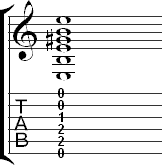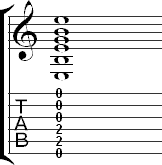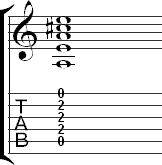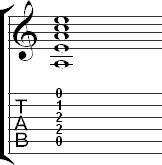What You Should Know
What You Will Learn
- Exercises to prepare for full barre chords
Preparing for Full Barre Chords
Preparing the Middle, Ring, and Pinky Fingers
The basic major and minor barre chords are based on open position chords. It is possible to move these chord voicings up the neck by using the index finger to barre five or six strings and fingering the remaining notes with the middle, ring, and pinky fingers. There are four major and minor barre chords that are used frequently. These chords are based on the open position E major, E minor, A major, and A minor voicings. You should have learned these chords in the introductory chords lessons.
New Fingerings for First Position Chords
Converting these first position chord voicings into barre chords requires the index finger to be used for the barre, leaving the other fingers free to play the remaining notes in the chord. This means that any notes fingered by the index finger in a first position chord has to be fingered by another finger when the chord is played as a barre chord, which completely changes the fingering for the chord. Because of this, it is useful to work on playing the first position chords with fingerings similar to what you will use when playing the barre chords, but without the index finger. This allows you to develop the ability to play the other notes in the chord before adding the barre. Here are the major and minor voicings again with the new fingerings:
E Major Chord
Chord Diagram

Tablature

E Minor Chord
Chord Diagram

Comments
Try to avoid muting the G string with your ring finger. Getting a clean chord with this fingering now will make it easier to do once you start playing the actual barre chord.
Tablature

A Major Chord
Chord Diagram

Comments
This fingering may be difficult due to the closeness of the fingers at the same fret. Try placing the pinky right behind the fret. The middle finger should be slightly further behind the fret, with the pinky being the furthest from the fret. These fingers should form an almost diagonal line. This should lessen the awkwardness of playing several notes at the same fret.
Make sure you aren't muting the high E string with your pinky.
Tablature

A Minor Chord
Chord Diagram

Comments
This chord has the same fingering as E major, just moved down a string. Avoid muting the first string with your middle finger.
Tablature

Work on each of these chords with the new fingerings until you can play them cleanly. The exercises below provide additional practice with these chords by moving the voicing up and down the neck.
These new fingerings are provided only for the purposes of preparing to play barre chords. When playing first position chords, such as E major, you should still use the fingering you learned in the lesson on first position chords.
Exercises
Exercises 1 through 4 provide an opportunity to practice each of these new chord fingerings up and down the neck. Each exercise deals with a different chord voicing and moves it up the neck.
Tips for Playing the Exercises
Sliding Up the Neck
Try to move to each new chord by lifting your fingers off of the strings slightly while keeping your fingers in the shape required for the chord. This will prevent string noise. You only need to lift your fingers off the strings far enough that you are no longer touching them.
The Thumb
Keep your thumb positioned behind the neck while doing this to provide stability while you slide up the neck. The thumb should not press against the neck at all while sliding. Any pressure from the thumb will result in a jerky motion when moving to the next chord. This should be a very smooth movement. You may want to try practicing switching back and forth between two chords until you are able to switch smoothly with no string noise.
Visualizing this Movement
Something that may help you visualize this is to think of it like rappelling. When rappelling, a person descends off a cliff or mountain by making short leaps backward while rope is paid out a little at a time with a rappelling device. Think of your fingers as the person making the leaps and the guitar neck as the cliff. Your fingers should leap out (only slightly) from the guitar neck while going to the next chord similar to the way a rappeller leaps out from the cliff. You may want to try this movement by exaggerating the leap with big movements to get the feel for how it works. You can then work on making the motion more economical.
If you find switching chords with this technique to be too challenging, you may slide along the strings while touching them for now. However, you should eventually try to improve your technique by using the approach described above.
Exercise 1

Exercise 2

Exercise 3

Exercise 4

The Five and Six String Barre
Practicing the barre by itself without having to play the rest of the notes in the chord is a good way to learn the proper technique for barring. This involves using the index finger to hold down five or six strings at once without fretting any other notes. The index finger should be held at an angle rather than flat.
Exercise 5
Exercise 5 is a simple barre exercise where a barre across all six strings are moved from the fifth to seventh fret and back down. Practice very slowly and make sure that all strings are ringing clearly. If necessary, try playing the barre at one fret and getting that clean before proceeding with the entire exercise.


Comments
Avoid muting the second string with the middle finger. Try to get a clean sounding chord before trying the exercise.